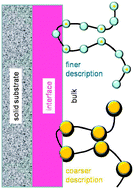Polymer–solid contacts described by soft, coarse-grained models
Abstract
The ability of soft, coarse-grained models to describe the narrow interface of a nearly incompressible  , strong differences in the interface tension and the density profiles between the two models are observed, and strategies for compensating the discrete nature of the bead-spring model are investigated. Compensating the discretization of the chain contour in the bead-spring model by applying an external segment–solid potential, we simultaneously adjust the interface tension and the density profile to the predictions of the Gaussian-thread model. We suggest that the geometry of the
, strong differences in the interface tension and the density profiles between the two models are observed, and strategies for compensating the discrete nature of the bead-spring model are investigated. Compensating the discretization of the chain contour in the bead-spring model by applying an external segment–solid potential, we simultaneously adjust the interface tension and the density profile to the predictions of the Gaussian-thread model. We suggest that the geometry of the

- This article is part of the themed collection: Multiscale modelling

 Please wait while we load your content...
Please wait while we load your content...